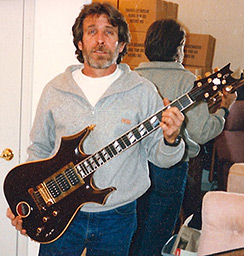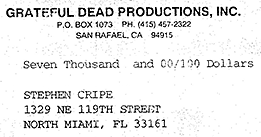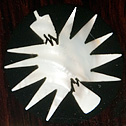| |
Click images to view larger.
He wanted to learn to play the guitar and started by building one. He purchased a book on guitar building in 1990 and began applying his woodworking skills to his new hobby. Working out of his house, he was initially frustrated with the process, commenting that, “due to errors in the book and a lack of musical instrument experience, my first guitar had a neck about the same size as the business end of a baseball bat!” He persevered, corrected his errors and after a short time trying to play the guitar, realized that he had more fun building them.
Cripe yearned for feedback on the quality of his guitars. A fan of the Grateful Dead since the early 1970s, he decided to make a guitar for Jerry Garcia and get his opinion. In March 1993, equipped with a copy of the Grateful Dead video “So Far”, he used the freeze frame feature of his VHS player along with a few pictures to study and fashion a guitar body closely resembling “Tiger”, the guitar Doug Irwin built for Garcia.

Freeze frame images from Grateful Dead “So Far” video Courtesy of Grateful Dead Productions, Inc.
He added his own unique design by laminating a nine-ply neck through the body construction. In addition, he created a distinctive headstock with a three-pronged asymmetric design at the top. Cripe said, “My logo, an exploding firecracker, is inlaid in the headstock.”

Steve Cripe holding a Lightning Bolt replica he made for a client.
Photo Courtesy of Pat O’Donnell, Resurrection Guitars
It was the seventh guitar he finished and it took him two months to complete.
Delivering the guitar to Garcia proved to be the real challenge. Through networking, Harriet Rose agreed to get it to Pam and David Grisman who saw that Garcia got the guitar.
In July 1993, Cripe got a message from Dennis McNally, the Grateful Dead publicist saying, “Jerry was fiddling around with the guitar and was intrigued by it and that this was a good sign.”
In August, Cripe got a call from Steve Parish, Garcia’s guitar tech, who said, “Jerry loved the guitar! He was using it for the Jerry Garcia Band and opening with it with the Grateful Dead.” Cripe said, “Parish went on to ask a lot of questions about the guitar and that’s when we officially named it ‘Lightning Bolt’ and he asked me to build a backup” guitar for Garcia.
Cripe asked Parish to “take measurements or draw a template of the neck” of the guitar. Parish was puzzled to learn that Cripe “winged it”, in terms of shaping the guitar from the video. Parish told him to “wing it” again and Garcia got on the phone and told him to “just do it. If I don’t like it, I’ll send it back”.
To better prepare this second guitar for Garcia, Cripe received guidance from Gary Brawer who handled Garcia’s guitar modifications. They spoke at length about Garcia’s preferences and Brawer sent him a video of electronics considerations. “Top Hat” was delivered to Garcia in November 1993. Garcia never returned it to Cripe.
Garcia referred to the guitars as Florida One and Florida Two.

|
 |
His first sale resulted in a check dated December 13, 1993, for $7,000 from Grateful Dead Productions, Inc. The check stub said, “Two Custom Guitars For Garcia OK Per Parish.”

Scan Courtesy of Pat O’Donnell, Resurrection Guitars
Cripe started to get noticed by Deadheads and orders for guitars started coming in. The Unbroken Chain, a Grateful Dead fan magazine, featured an article written by Cripe called “Jerry’s New Guitar,” in its 47th Edition, March 1994 issue.
Courtesy of Garcia, Cripe received backstage passes to a run of Grateful Dead concerts at the Miami Arena on April 6, 7, and 8, 1994. He witnessed the performance next to the drums about nine feet behind Garcia.
Cripe’s first and only meeting with Garcia was at these shows. Cripe said, “We spent about forty-five minutes talking about guitars. He (Garcia) said that both instruments looked like museum pieces.” Ironically, they are both now being exhibited at the Rock and Roll Hall of Fame and Museum in Cleveland, Ohio.
Cripe told the St. Petersburg Times, “It took me a while to get anything out of him about how he would change the guitar.” However, Cripe noted that Garcia said, ‘it’s almost like I sent you the specs for what I was really looking for in a guitar.’ The whole thing was just great; it was a highlight of my life.”
Cripe moved from Miami to Trilby, FL, in 1994, to be closer to his parents who lived in Spring Hill, FL. There he built a workshop to construct his guitars for his growing business. In the same work area, to supplement his guitar enterprise, he also made fireworks.
Cripe again received tickets and backstage passes to a Dead concert in Tampa, FL, on April 7, 1995. He did not get to see Garcia but he met with Parish who told him “’Lightning Bolt’ held up better than any other guitar Jerry has owned and that Jerry was playing “Top Hat” at home.”
Around the time of Garcia and Cripe’s birthday in 1995, August 1st and 6th respectively, Cripe was working with a leftover piece of wood from “Lightning Bolt” when he started getting “strong feelings about Jerry”. That week, August 9, 1995, Garcia died.
Cripe’s second article appeared in Issue 54 of Unbroken Chain, in which he elaborated on the details of making Garcia’s guitars. When asked, “What will happen to the guitars? Will you get them back?” Cripe said, “It would be nice to have “Lightning Bolt” back so I could take pictures of it.” He never saw the guitar again. Bemoaning Garcia’s death, Cripe’s last words in the article were “At least we have the tapes (referring to audio tapes of live Grateful Dead concerts).”
In the spring 1996, Cripe met Pat O’Donnell of Resurrection Guitars at a guitar show in Orlando. Pat said, “I was strolling around the show when I passed a booth that had these amazing guitars. It turned out to be Hal Hammer’s booth. I asked who owned the guitars and Hal told me they were his friends’ guitars, Steve Cripe. Cripe showed up and we struck up a lengthy conversation that went well into the night.”
Tim O’Donnell, Pat’s son says, “they both had similar backgrounds in the boat and woodworking business. They left the show and weren't seen for the rest of the day. Pat was amazed at the woodworking and artistic skill in Cripe’s guitars and Cripe was amazed that Pat could make a five pound guitar sound so good with massive sustain.” They talked by phone over the next few weeks and planned to attend NAMM together but it never happened.
Next: Epilogue |





